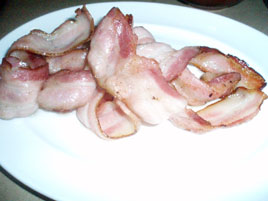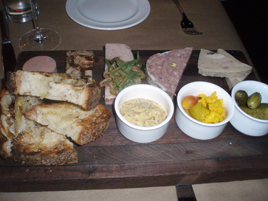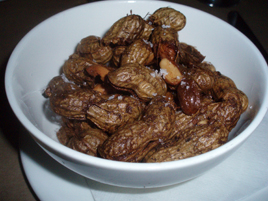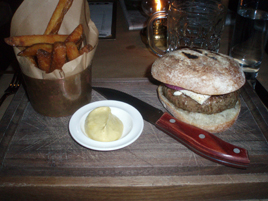
Note: This is a review under founding chef Tien Ho, who has since left the restaurant. The new chef, Paul Carmichael, is introducing an American menu.
David Chang is the unquestioned King of the East Village, with four insanely-popular Momofuku restaurants to his name, holding six New York Times stars and two Michelin stars between them.
Does Chang’s hipster ethos work in a midtown luxury boutique hotel? That was the question when he took over the former Town space in the Chambers Hotel on West 56th Street.
Town had long ceased to be culinarily relevant when it closed in April 2009, but at least it offered the high-end, French-inflected fine dining experience that guests at the Chambers would expect. Chang’s new landlord probably wanted nothing to do with a name like “Momofuku,” which to the unanointed reads like Mother-Fuck-You.
So Chang settled on Má Pêche (Momofuku means “peach”), which gives the surface impression of bourgeois respectability. What he built, however, is “Momofuku for Tourists,” a restaurant that resembles his East Village empire the way Disney’s Epcot resembles France or Italy.
 The only trouble is, so far the tourists haven’t shown up. On a Friday evening at 8:00 p.m., Má Pêche was two-thirds empty. During our meal, we saw four separate parties enter the dining room, take one look, and then leave.
The only trouble is, so far the tourists haven’t shown up. On a Friday evening at 8:00 p.m., Má Pêche was two-thirds empty. During our meal, we saw four separate parties enter the dining room, take one look, and then leave.
What could have turned them off? Perhaps it’s the huge, X-shaped communal table that dominates the room, a feature of many New York restaurants, but probably unfamiliar to the businessmen from Chicago or the honeymooners from Des Moines.
Má Pêche, unlike the other Momofukus, does have detached tables and chairs with backs, but the communal table is the first thing you see. If Chang knows what’s good for him, he will get rid of it.
Like all of Chang’s downtown places (except Momofuku Ko), Má Pêche doesn’t take reservations. That policy works when you’re getting enough foot traffic to remain constantly full. And what about the nonsense of serving dessert only at the adjoining “Milk Bar”? It works in the East Village. At a midtown luxury hotel, it’s a recipe for failure.
Chang apparently realized that a midtown crowd will expect better service than at his East Village places. A memo to staff was leaked to Eater.com, describing the service rules in detail. Our server was clearly struggling, practically reciting them to us as he served the wine, to ensure he hadn’t left anything out. But if they’re so persnickity, why are there still paper napkins, when dinner for two will easily run up to $150 or more, especially if you order from the over-priced, unimpressive wine list?
The chef de cuisine is Tien Ho, who used to run the kitchen at Momofuku Ssäm Bar. The menu is written in a French–Vietnamese pidgin that I suspect many customers will find utterly baffling. The food seemed to us no more Vietnamese than Chang’s East Village restaurants are Korean.
None of this would matter if the food at Má Pêche were anywhere near as good as it is downtown. The four dishes we tried were shockingly insipid, unadventurous: bland. There is very little to tempt the original Momofuku clientele to make the trip uptown, while those who never bought into Chang’s act (or never heard of it) will be wondering, “Where’s the beef?”
Actually, beef is the one distinctive offering: a traditional Vietnamese “Beef 7 Ways” dinner for 6–10 people that runs $85 a head, and is currently the only option for which reservations are taken. But this certainly won’t attract tourists and business travelers, who won’t know all the tricks of visiting the Momofuku website, poised to click on the green check mark at exactly 10:00 a.m., a week in advance.


Mang tây gribiche ($18; above left) is typical of the menu’s timidity. Asparagus salad, crab, and egg yolk sounded promising, but the egg tasted like the egg salad that comes out of a buffet line, and I didn’t taste much crab at all.
Chou-fleur chiên ($12; above right) was the dish I ordered and enjoyed on my last visit, but this time the fried cauliflower was a flat, soggy mess, and the curry was so weak as to be almost non-existent.


Aloyau de porc ($36; above left) is the most expensive of the entrées. You get plenty for your money, as it’s a twenty-ounce pork porterhouse that two can easily share. But it was curiously flavorless and was sliced too thin, causing it to slightly dry out in the process. However, we liked the fingerling potatoes and English peas that accompanied it.
Bun du riz ($18; above right), or rice noodles with spicy pork, had great potential if only the pork were spicy. Instead, it almost completely failed to register.
Má Pêche today is like a mirror-image SD26, the former uptown luxury Italian restaurant that is now trying (and failing) to appeal to the downtown crowd. We suspect that David Chang is more adaptable than SD26’s Tony May.
Adapt he must. If he wants to bring in the tourists and businessmen, he needs to ditch the communal table and paper napkins, take reservations, and serve a menu they’ll understand. If he wants to attract New Yorkers, he needs to take some culinary risks. If he wants to do both…well, that just might be impossible.
Má Pêche (15 W. 56th Street between Fifth & Sixth Avenues, West Midtown)
Food: *
Service: *
Ambiance: *
Overall: *

 Thursday, September 2, 2010 at 03:41PM
Thursday, September 2, 2010 at 03:41PM 









































